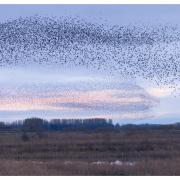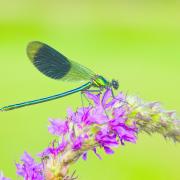They’re the go-to creature when it comes to adding a touch of horror, but bats have a softer side too, and are even good to have around. Tom Marshall from the Yorkshire Wildlife Trust explains.
Bats really do have an image problem. Batman himself may be the definitive after-hours super hero, but his name still strikes fear into all those who cross his path, while almost every horror movie of the last century also paints them in a less than complimentary light. Walk into a cave without a torch in any film you care to mention and you can almost guarantee thousands of bats will come flapping out in a flurry of wings, with the main protagonist running off screaming into the distance.
So do these diminutive creatures of the night deserve their dodgy billing? Perhaps the most obvious myth to bust for those of us in the UK, is that our own British bats are nowhere near as large as their Hollywood counterparts. Even our largest species, the noctule, has a wingspan little larger than the spread hands of most of us, at just over a foot in length. More typically, our most familiar bats – the pipistrelles, have a body barely larger than our thumb. At that size, you’d struggle to strike fear into even the most mild-mannered person in a darkened cellar.
By being ‘blind as a bat’, you could also be fooled into thinking they don’t have the best sense of direction either – but nothing could be further from reality. With one of the most highly advanced sensory set-ups in the animal world, bats are capable of detecting the tiniest of changes in their surroundings – so there’s little chance of a poorly judged landing in your new hairdo. How they manage this is that famous echo-location, a strategy most easily likened to aerial sonar, with the bats bouncing clicks off nearby objects and measuring the time it takes to come back – all in a millisecond, and thousands of times a minute.
So with this unparalleled sat nav on board, will they be heading towards the nearest neck for a blood-thirsty drink? Only if you’re a moth. All of Britain’s 17 species of bat feed on insects, via a stunning variety of dining techniques that includes picking them clean out of the air, ‘gleaning’ off leaves in the woodland canopy and even scooping them off the water’s surface in the case of Daubenton’s bats. Fans of Scotland’s west coast or our late summer uplands will also be pleased to hear that midges make a popular bat snack.
With such high levels of activity, its small wonder that bats’ appetites match their frantic behaviour, with even the smallest pipistrelle capable of catching up to 500 insects an hour or around one every ten seconds.
As mammals (around one in four of the world’s mammals are bats), bats also have a surprisingly dedicated parenting regime, with expectant mums gathering in so-called ‘maternity roosts’. As well as gathering for breeding, hibernation also sees bats come together in greater numbers. Whether in a tree, cave or man-made structure, bats slow down their heart rate and breathing to just enough to allow their key body functions to continue, and also reduce their temperature. This time finds bats at their most vulnerable, and it doesn’t take much to understand the impact that waking a bat in the middle of winter with little or no insect prey around may have. As our climate and weather changes too, this can provide additional and confusing challenges.
Although we may catch the odd glimpse in our headlights or a flickering shadow across a street lamp (it’s thought these may even aid feeding opportunities), most of us will encounter bats quite by accident when clearing out the loft or dusty outbuildings. The often unexpected nature of these experiences has no doubt exacerbated the bats’ disappointing showing in the popular wildlife rankings, but ironically it’s our own homes and gardens that may yet prove to be the saving grace for Britain’s bats.
The collective area of Britain’s 15 million gardens is larger than all the country’s nature reserves put together; small wonder then that the battle to save our biodiversity really does start at home. In much the same way as the ‘tidying’ of our homes and gardens over recent decades has affected cavity nesting birds like starlings, house sparrows, martins and swifts, so too our bats are struggling to find a suitable des res.
Thankfully, if you prefer your very own midge-eating machine alongside a summer barbeque then there are plenty of easy steps to take – without the need to get out the garlic or a silver stake.
Become a batty bistro
If you plant it, they will come (the moths that is) and the bats will gratefully make use of your after-hours takeaway while you’re fast asleep. Adding a few different choices to your border such as honeysuckle, cosmos, verbena, evening primrose, hemp agrimony and ivy will keep the moths – and in turn the bats – well fed. Avoiding chemical pesticides will help maintain normal levels of invertebrate predators, nature’s own pest control.
Go long
Allowing a small patch of the garden grass to grow longer (and in turn support wildflowers) will also attract pollinating insects and bats. You can see what Mother Nature offers you in the first season, or cheat with one of the many inexpensive, professional wildflower mixes – but be sure to choose British native favourites. For an instant effect, wildflower turf is even available, just roll out and voila. This type of habitat is becoming increasingly important as gardeners turn to maintenance free artificial grass at an alarming rate, offering nothing to our wildlife.
Home from home
In the same way as bird nestboxes have advanced immeasurably in recent years, there is now an equally dazzling variety of bat homes too. Like their feathered counterparts, the top choice is usually ‘woodcrete’ – a thermo-regulating material ideally suited for seasonal maternity or roosting, and almost bombproof to other would-be intruders. Boxes can be placed high in a tree or on the house itself, or the for the really keen try in-built boxes in your new roof or extension.
Dark night detectors
With your garden irresistible to these tiny caped crusaders, you can join in the conversation too with a bat detector. Now relatively inexpensive, bat detectors are able to tune in to the echo-location calls of bats by tracking the relevant frequencies. Converting the clicks into audible human frequencies means you can follow a variety of different species at the turn of a dial, so it’s great fun for youngsters too.
Wild about gardens
Every autumn, the Wildlife Trusts and the Royal Horticultural Society team up to celebrate some of our back garden favourites – and this year it’s all about the bats. Wild About Gardens Week runs from October 24-30 and you’ll find top tips, local events and hands-on advice online atv wildaboutgardensweek.org.uk. Keep an eye on social media on #WildAboutGardens for all the latest ideas from across the country.


























